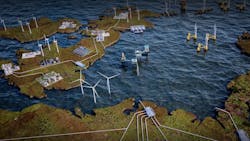Game-changing technology propelling the energy transition
Editor's note: This story first appeared in the March-April 2023 issue of Offshore magazine's Energy Transformation Strategies Special Report.
By Myrtle Dawes, Net Zero Technology Centre
Technology innovation and digital transformation are fundamental to the energy transition. Realizing the value of nascent technologies takes time; however, the urgency for energy security and affordability against the backdrop of the climate crisis that envelops us, means time is not on our side.
Scotland’s Net Zero Technology Centre (NZTC) is developing and deploying technologies that are designed to reduce emissions, unlock the full potential of an integrated energy system and propel the energy industry toward a digital, automated, decarbonized future.
Reducing emissions from offshore operations, whether through eliminating leaks, flaring and venting, employing low-emission logistic strategies, and/or repurposing infrastructure must be a priority for the offshore energy industry. There have been many technology advances in this space.
Along with Siemens Energy, NZTC has recently completed a key deliverable in its Alternative Fuel for Gas Turbines project with a successful pilot of running an aero-derived gas turbine on green methanol. This type of R&D is a big step toward enabling some offshore assets to operate using low-carbon fuels without extensive modifications. The use of green methanol has the potential to cut CO2 emissions by up to 70% compared to conventional fuels across the UKCS.
Hydrogen
Hydrogen will facilitate various decarbonization applications. NZTC’s Hydrogen Backbone project considers how a hydrogen pipeline network could be established between energy hubs and existing national grid infrastructure, linking ports and other infrastructure. While NZTC's Liquid Organic Hydrogen Carrier (LOHC) for Hydrogen Transport from Scotland project will demonstrate that LOHC, in the form of methylcyclohexane, can be successfully transported at scale, providing an export route to the Port of Rotterdam and other European destinations. The project is delivered by a diverse, international consortium, including Axens, Chiyoda, EnQuest, ERM, Koole Terminals, Port of Rotterdam, Scottish government, Shetland Islands Council, Suncor and Storegga.
Offshore robotics
Digitally based technologies empowered by data, robotics and autonomous systems will optimize and enable remotely controlled operations. Placing technology at the forefront of operations, NZTC’s Offshore Low Touch Energy Robotics and Autonomous Systems are delivering the competences necessary to engage, anchor and utilize a robotics and autonomous systems supply chain. Beyond Visual Line of Sight demonstrators have shown the art of the possible by using commercial drones to autonomously deliver critical payloads across onshore sites. Further demonstrations for air, land and sea-based robotics will take place in 2023 in an offshore environment supporting the development of best practice to inform industry standards.
Innovation is happening, and transformation is sweeping the world, albeit adoption and scaling is slow. Increased investment in clean energy technologies, economies of scale and regulation will help to de-risk technology and bring down costs. This is an exciting time for the offshore energy industry, and it’s only just the beginning.
About the author:
Myrtle Dawes is the solution center director with Net Zero Technology Centre.


